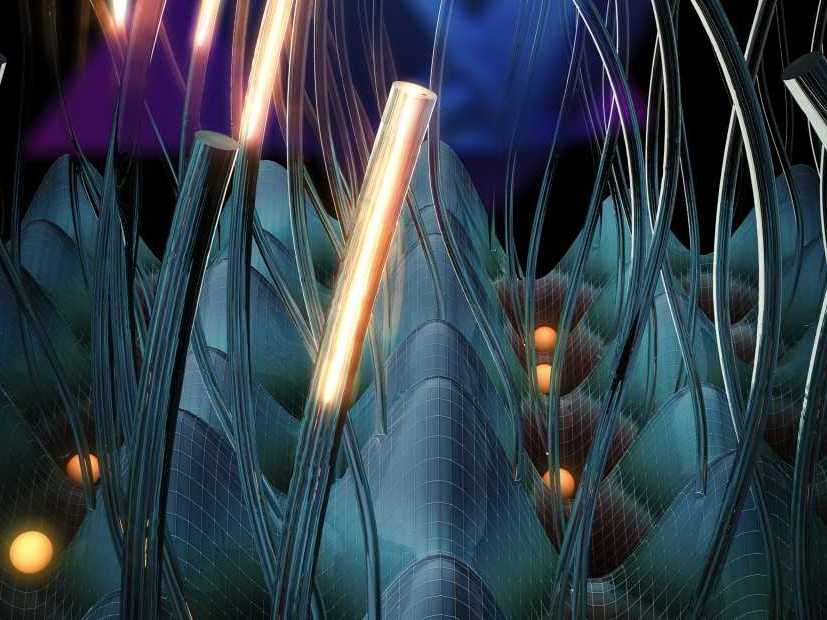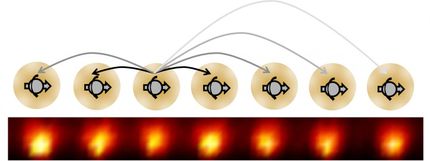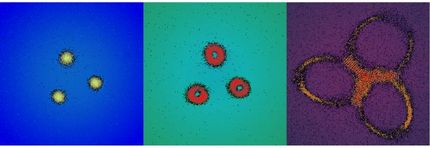A look into the fourth dimension
Advertisement
In our daily experience space has three dimensions. Recently, however, a physical phenomenon that only occurs in four spatial dimensions could be observed in two experiments. The theoretical groundwork for those experiments was laid by an ETH researcher.

A physical phenomenon in four spatial dimensions was realized in two experiments: with light in waveguides (winding tubes) and using cold atoms (orange spheres) in optical lattices.
ETH Zürich
Ever since Albert Einstein developed the special theory of relativity in Zurich in 1905, by «fourth dimension» one usually means time. But how can one visualize a fourth spatial dimension – in addition to top-bottom, right-left and front-back? In the arts Salvador Dalí tried that: his crucifixion scene painted in 1954 shows as cross consisting of the three-dimensional unfolding of a hypercube in four dimensions (similarly to the unfolding of a cube into squares).
A completely different, but no less fascinating, look into the fourth spatial dimension was now obtained by two teams of scientists from Switzerland, USA, Germany, Italy and Israel. The ETH researcher Oded Zilberberg, professor at the Institute for Theoretical Physics, played a pivotal role in both publications, which were recently published in the scientific journal Nature. He provided the theoretical basis for the experiments in which a four-dimensional physical phenomenon could be observed in two dimensions.
The quantum Hall effect
Both experiments dealt with the so-called quantum Hall effect. Commonly, that effect manifests in the boundary layer between two materials, in which electrons can only move in two dimensions. A magnetic field perpendicular to the material initially leads to the classical Hall effect: a current flowing through the material gives rise to a voltage in the perpendicular direction – the larger the magnetic field, the higher the voltage. The reason for this is that the magnetic field generates a force acting at right angles to the direction of motion (the Lorentz force) that deviates the electrons. At very low temperatures and very large magnetic fields, however, quantum mechanics starts playing a role, which means that the voltage no longer increases continuously, but rather jumps in discrete steps. Three Nobel Prizes in Physics have so far been awarded for experimental and theoretical work on the quantum Hall effect.
A question of topology
The quantum Hall effect can also be understood as a topological phenomenon. Topology describes, for instance, how many “holes” an object has and into what other shapes it can be transformed without cutting it. Similar laws are responsible in the quantum Hall effect for the electrons’ only being able to move along topologically well-defined paths. For particular strengths of the magnetic field, for example, the electric current can only flow along the edges of the material, but not inside it. Around twenty years ago, it was shown mathematically that analogous topological effects should also occur in four spatial dimensions. “At the time, however, that was more like science fiction”, says Oded Zilberberg, “as actually observing something like that in an experiment seemed impossible – after all, physical space only has three dimensions.”
Virtual dimensions by topological pumping
But Zilberberg had a clever idea: using so-called topological pumps it should be possible to add a virtual dimension to both of the real dimensions of the quantum Hall effect. A topological pump works by modulating a specific control parameter of the physical system, which causes its quantum state to change in a characteristic way over time. The end result then looks as though the system had been moving in an additional spatial dimension. In this way one can, theoretically, turn a two-dimensional system into a four-dimensional one.
An optical image of the fourth dimension
That this can also work in practice has now been shown in two independent experiments. A team of physicists led by Mikael Rechtsman at Penn State University and including Kevin Chen’s group at the University of Pittsburgh in the USA has realized Oded Zilberberg’s idea by burning a two-dimensional array of waveguides into a fifteen-centimetre-long glass block using laser beams. Those waveguides were not straight, however, but rather meandered through the glass in a snake-like fashion so that the distances between them varied along the glass block. Depending on those distances, light waves moving through the waveguides could jump more or less easily to a neighbouring waveguide.
The varying couplings between the waveguides acted as topological pumps and thus doubled the number of dimensions of the experiment from two to four. The researchers could now literally “see” the expected four-dimensional quantum Hall effect by feeding light into the waveguides at one end of the glass block and recording what came out at the other end with a video camera. In this way, for instance, the characteristic edge states of the four-dimensional quantum Hall effect, in which light should emerge only from the waveguides at the edge of the lattice, became directly visible.
Four-dimensional quantized transport
Using extremely cold atoms trapped in optical lattices made of crossed laser beams, Immanuel Bloch and his collaborators at the Max-Planck-Institute for Quantum Optics in Munich also realized topological pumps. In their experiment, the pumping was effected by periodically varying the properties of the split lattice wells in which the atoms were trapped. By measuring the resulting two-dimensional motion of atoms in the lattice they were able to confirm that the atoms, indeed, behaved according to the topology of the quantum Hall effect in four dimensions. In particular, they were able directly to observe the quantized transport phenomena predicted to occur in that case (which are the equivalent of the voltage perpendicular to the direction of the current in the ordinary two-dimensional quantum Hall effect).
Progress in fundamental research
So what’s the practical use of all this? “Right now, those experiments are still far from any useful application”, Zilberberg admits. But for fundamental research they represent important progress. Physicists can now investigate not just on paper, but also experimentally the effects that phenomena occurring in four (or even more) dimensions can have in our usual three-dimensional world. Quasicrystals in metallic alloys are one example. In three spatial dimensions such quasicrystals have no periodic structure, but when one looks at them in higher virtual dimensions, they actually exhibit regular patterns. And, finally, there is string theory, according to which higher spatial dimensions are “compactified” in such a way that, at the end, our normal three-dimensional world emerges.
Original publication
Lohse M, Schweizer C, Price HM, Zilberberg O, Bloch I.; "Exploring 4D quantum Hall physics with a 2D topological charge pump"; Nature 553, 55–58 (04 January 2018).
Zilberberg O, Huang S, Guglielmon J, Wang M, Chen KP, Kraus YE, Rechtsman MC; "Photonic topological boundary pumping as a probe of 4D quantum Hall physics"; Nature 553, 59–62 (04 January 2018).



































































